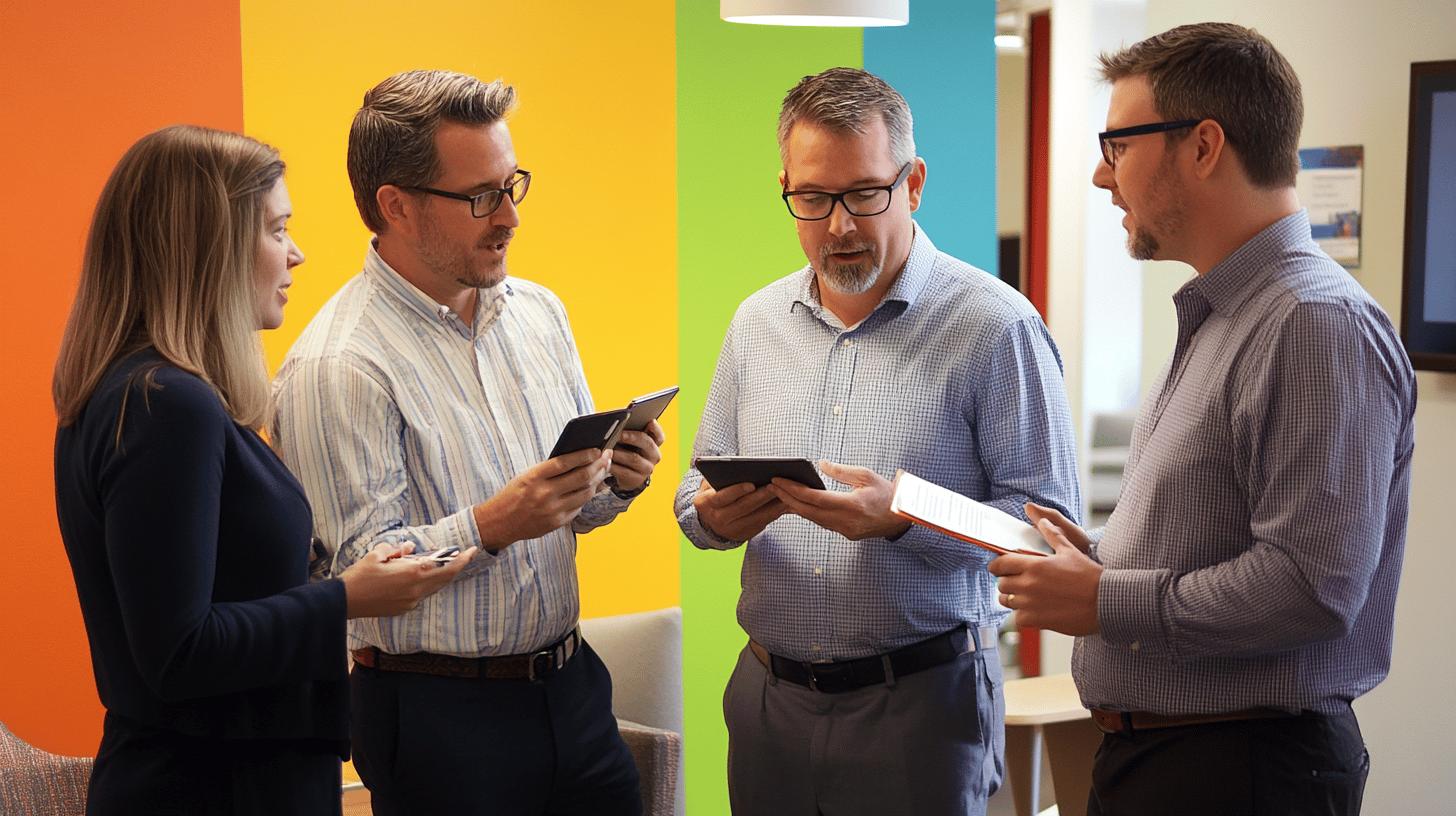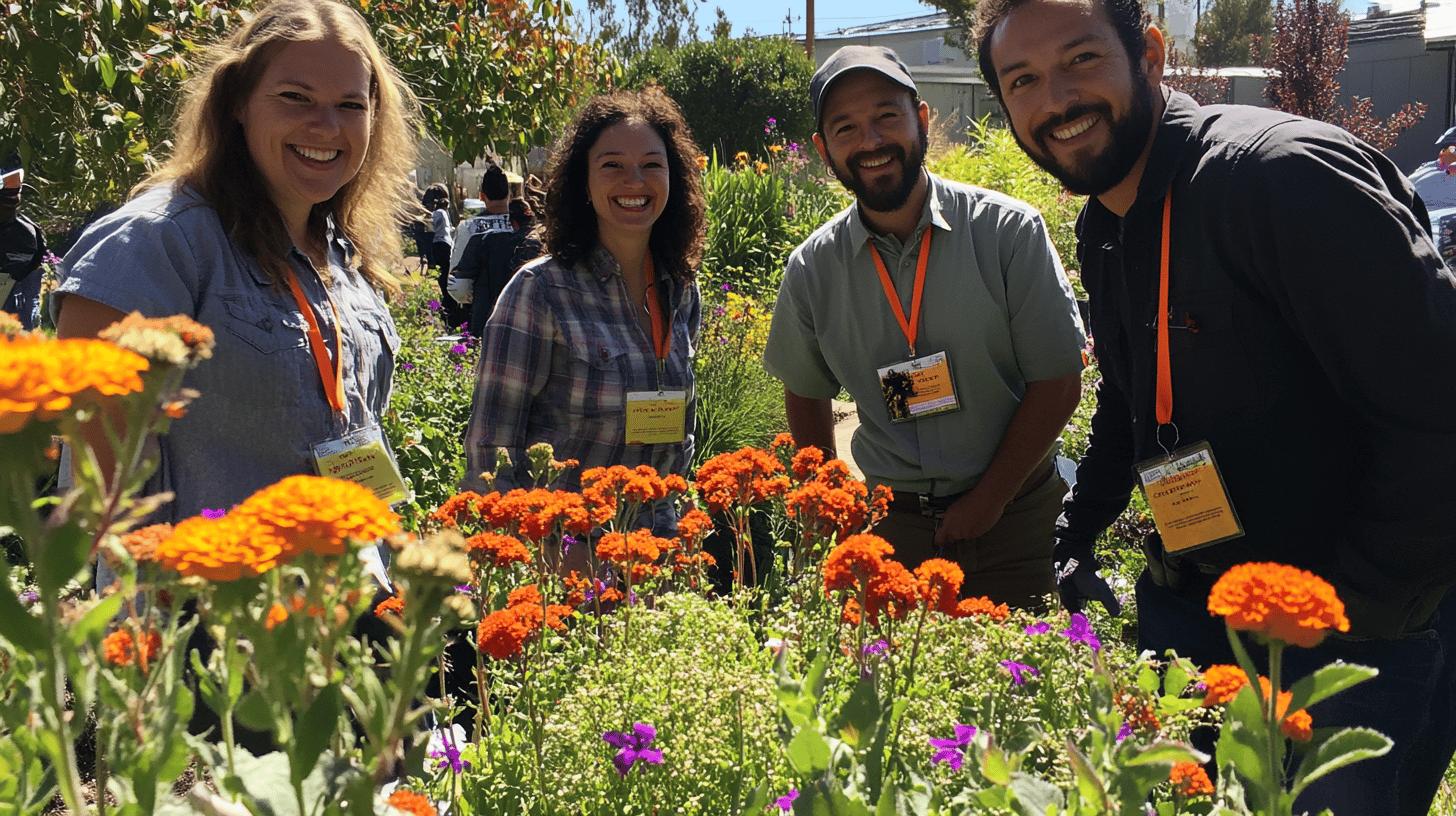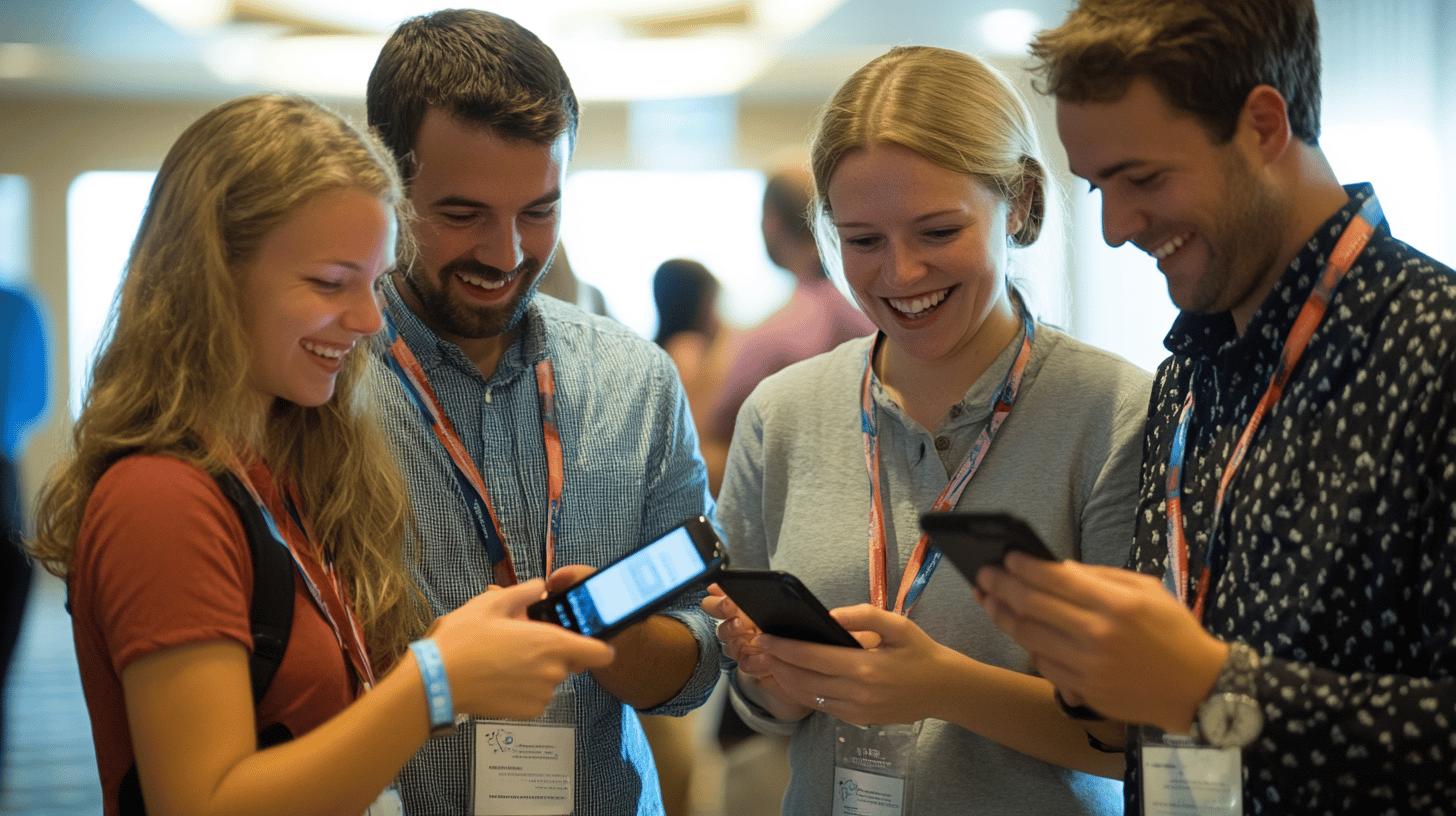Networking at conferences offers unparalleled opportunities to build lasting professional relationships. However, turning initial interactions into authentic community connections requires strategic approaches and diligent follow-ups.
This article dives into actionable conference networking ideas, specifically tailored for those seeking genuine engagement in both in-person and virtual settings. From preparing with effective conversation starters to leveraging technology tools like conference apps and the Journey platform, this guide equips attendees with innovative tactics to capitalize on every chance to connect. Additionally, the outlined strategies will cover creative activities and post-event follow-ups, ensuring your conference networking efforts translate into meaningful, ongoing professional growth.

Effective conference networking hinges on thorough preparation and intentional engagement. Reviewing the delegate list and researching attendees’ backgrounds helps participants identify like-minded individuals to connect with, fostering more meaningful conversations. Designing a personal schedule around the event agenda ensures time is allocated for both formal sessions and informal mingling, allowing for organic relationship building. Preparing conversation starters and a concise elevator pitch tailored to the conference theme boosts confidence and opens pathways to deeper dialogue.
Leveraging digital tools enhances these efforts by streamlining how attendees discover and engage with relevant contacts. Platforms like Journey serve as a robust backbone for this process, offering customizable community creation flows and member directories to help users find peers who share their passions and goals. Journey’s AI-powered features facilitate introductions, recommend relevant content, and organize virtual or in-person meetups, enriching the networking experience beyond traditional methods. These tools support continuous interaction and help maintain connections long after the event concludes.
The benefits of structured networking extend well beyond the conference itself. Attendees gain enhanced connection opportunities by intentionally engaging with diverse professionals, improving time management by aligning their schedule with key networking moments, and accessing valuable contacts who can contribute to their personal and professional growth. Moreover, implementing post-event follow-up strategies ensures relationships evolve into lasting communities. Platforms like Journey empower users to nurture these bonds through seamless communication, resource sharing, and ongoing engagement within vibrant, focused communities.

Designing creative in-person networking experiences at conferences is crucial for fostering genuine connections among like-minded professionals. Scheduled meet-ups provide structured opportunities for attendees to gather and engage around shared interests, while informal gatherings in common spaces encourage spontaneous interaction. Incorporating engaging icebreakers like Human Bingo or interactive name-tag enhancements helps break down social barriers, inviting participants to connect more openly. Thematic discussion zones focused on specific topics or industries create natural hubs for rich, focused conversations and resource sharing.
Executing these creative networking techniques requires thoughtful planning. Organizers can set up designated spaces with clear signage and comfortable seating to encourage attendees to linger and engage deeply. Icebreaker activities can be introduced at the start of sessions to energize participants, while themed zones can rotate topics throughout the event to cater to diverse interests. Adding interactive elements, such as workshops or collaborative exercises, encourages active participation and helps attendees build meaningful relationships beyond surface-level exchanges.
The benefits of integrating creative in-person networking ideas are manifold. Attendees experience a sense of belonging and mutual support as they discover peers with shared passions. These strategies enhance communication, foster long-term engagement, and enrich the overall conference experience. Platforms like Journey complement these efforts by enabling communities to extend interactions beyond the event, offering tools that support continuous dialogue, event planning, and resource sharing. This blend of onsite creativity and digital community-building ensures connections made at conferences develop into lasting, vibrant networks.

Virtual networking presents unique challenges, such as limited face-to-face interaction and difficulties in building trust quickly. To overcome these obstacles, attendees can engage in research-driven strategies, preparing by reviewing participant profiles and event agendas ahead of time. Utilizing online meeting tools that support video, breakout rooms, and screen sharing helps create a richer interaction environment. Incorporating digital icebreaker games encourages participation and eases initial conversations, making virtual spaces feel more inviting and dynamic.
Effective virtual networking hinges on leveraging technology to simulate in-person connection opportunities. Interactive breakout rooms enable small-group discussions focused on specific topics or industries, fostering deeper engagement among like-minded individuals. Virtual scavenger hunts and other gamified experiences promote spontaneous interaction, encouraging attendees to explore and connect beyond scheduled sessions. These methods enrich the virtual event atmosphere, helping participants form genuine bonds despite physical separation.
Platforms like Journey enhance virtual networking by providing an integrated social network designed for authentic connections and sustained community engagement. Journey’s customizable community creation tools allow event organizers to build focused groups with tailored privacy settings and member roles. The AI-powered Sidekick supports personalized introductions, recommends relevant content, and organizes virtual meetups or coffee chats, making it easier for attendees to discover peers who share their passions. Journey’s seamless mobile accessibility and robust communication features ensure that these connections continue to grow organically long after the event ends.

Speed networking is a powerful technique that enables attendees to make meaningful connections quickly and efficiently. By structuring brief, timed interactions, it encourages participants to focus on concise elevator pitches that clearly communicate their interests and expertise. Typically, sessions are organized with strict time slots—often one to two minutes per interaction—ensuring a dynamic flow where attendees meet multiple like-minded individuals within a short period.
To maximize engagement, creative icebreakers complement speed networking by fostering openness and easing initial nerves. Popular activities include Two Truths and a Lie, where participants share two facts and one false statement about themselves, prompting curiosity and laughter. Rapid-fire question rounds also stimulate fast-paced exchanges, helping attendees discover shared interests and spark follow-up conversations. These icebreakers break down social barriers and create a relaxed environment essential for genuine connection.
The expected outcomes of combining speed networking with engaging icebreakers include enhanced communication skills, expanded professional networks, and a stronger sense of community belonging. Participants walk away with valuable contacts and richer experiences, ready to build on these connections long-term. Platforms like Journey further support this by enabling users to continue conversations, organize follow-up meetups, and maintain vibrant communities beyond the event.

Tailoring networking strategies to specific audiences is crucial for fostering authentic connections that resonate deeply. College students benefit from environments that blend learning with social interaction, such as university networking mixers designed to connect emerging professionals with seasoned mentors and peers. Young professionals focused on career growth thrive in breakout sessions that emphasize skill-building, industry insights, and goal setting, creating a platform for meaningful exchanges. High school students gain from mentorship meetups that provide guidance and encouragement, helping them navigate early career decisions through supportive community engagement.
Women’s networking events hold a unique place in fostering empowerment and mutual support. These forums cultivate safe, trustworthy spaces where participants can share experiences, discuss challenges, and celebrate achievements. By aligning activities with the interests and needs of women professionals, these events enrich communication and build a vibrant sense of belonging. Journey’s customizable community creation tools enable event organizers to craft these focused spaces, allowing members to interact, participate in discussions, and access resources tailored specifically to their goals.
Journey’s robust platform supports these diverse groups by providing seamless tools for community management, event organization, and member engagement. The AI Sidekick enhances discoverability and encourages continuous participation, making it easier for people within niche groups to find relevant connections and maintain long-term relationships. This integrated approach ensures that networking at conferences extends beyond the event, organically growing vibrant communities centered on shared interests and authentic support.

Digital networking tools play a crucial role in amplifying the effectiveness of conference networking by creating seamless connections among attendees. Technologies such as QR code connections simplify the exchange of contact information, enabling instant sharing without the hassle of paper cards. Conference apps serve as a centralized hub for schedules, profiles, and messaging, enhancing discoverability and interaction before, during, and after events. Social media integration allows participants to showcase their professional presence and contributions, fostering ongoing engagement beyond the physical conference space. Digital name tags add a layer of personalization by displaying additional details, sparking conversations and helping attendees remember one another more effectively.
Platforms like Journey elevate these tools by offering a robust, integrated environment designed specifically for genuine community building. Journey supports diverse, customizable community creation with flexible privacy and member role options, ensuring a safe and trustworthy space tailored to each group’s needs. Its AI-powered Sidekick enhances networking by recommending relevant connections, organizing meetups, and facilitating meaningful discussions. Journey’s seamless mobile accessibility and content management features encourage continuous participation and enrich the essence of authentic networking well beyond the event itself. This blend of technology and thoughtful design empowers attendees to expand their networks, deepen relationships, and foster long-term belonging in vibrant professional communities.

Sustaining connections after a conference is crucial for turning initial meetings into long-term, fulfilling relationships. A well-planned follow-up strategy acts as the backbone for continued engagement, allowing attendees to nurture the rich interactions they initiated during the event. Timely communication, thoughtful outreach, and organized management of contact information help maintain momentum and deepen professional growth through networking.
Effective post-event follow-up begins with organizing contact information in a well-maintained system. This organization supports personalized communications tailored to each connection’s interests and expertise. Sending personalized follow-up emails that reference shared discussions or goals fosters mutual respect and encourages continued dialogue. Scheduling follow-up meetings or virtual coffee chats provides structured opportunities to explore collaboration and resource sharing in a focused environment.
Platforms like Journey enhance these efforts by offering robust tools for managing contacts, organizing community interactions, and facilitating continuous participation. Journey’s customizable community spaces serve as a safe, vibrant hub where attendees can join discussions, share updates, and access relevant resources long after the conference ends. The AI Sidekick further enriches this experience by recommending relevant connections and organizing meetups, ensuring that professional relationships grow organically and meaningfully.
Engaging in conferences offers numerous networking possibilities. Exploring diverse ideas, from preparation to virtual solutions, attendees gain valuable insights. Innovative and creative strategies transform networking experiences, making them more effective and enjoyable.
With well-planned approaches, nurturing connections becomes seamless. Ultimately, these ideas foster meaningful community ties. Embracing these techniques ensures conference networking transcends beyond the event itself, offering opportunities for continued professional growth. Implementing such strategies with dedication promises success and fulfillment.
Whether in-person or virtual, the conference networking ideas discussed elevate one's ability to build lasting, impactful connections.
Students can enhance their networking by preparing thoroughly. Reviewing delegate lists, designing a personal agenda, and preparing conversation starters are key practices. This ensures students can make meaningful connections and gain valuable insights.
Small groups can benefit from themed discussion zones, interactive workshops, and structured business card exchanges. These activities foster intimate conversations and can be tailored to specific interests, enhancing the overall networking experience.
Fun networking activities include Human Bingo and themed icebreaker sessions. These activities encourage professionals to interact in a relaxed environment, making it easier to build genuine connections.
Effective networking facilitation includes organizing speed networking rounds and thematic breakouts. These methods offer structured interactions, allowing attendees to meet numerous contacts in a short period, optimizing engagement opportunities.
Networking events for young professionals should include engaging icebreakers, speed networking sessions, and career-focused discussions. Such events help build industry connections and offer career development insights.
Unique ideas include using conference apps to connect attendees, incorporating digital name tag enhancements, and creating dedicated networking spaces. These approaches provide creative avenues for making lasting impressions.
Virtual networking can be enhanced using digital tools like virtual scavenger hunts and interactive breakout rooms. These methods facilitate engaging interactions, even in a digital setting, making connections more meaningful.
Good questions include asking about current projects, industry trends, or professional challenges. These questions facilitate deeper conversations and can lead to valuable insights and opportunities.
Effective conversation ideas focus on exploring shared interests or industry experiences. Discussing recent trends or collaborative opportunities can foster engaging interactions and build a strong professional rapport.